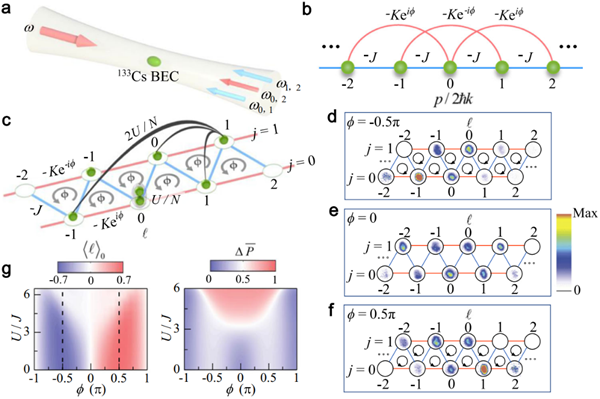Recently, the research team made breakthrough progress in the study of artificial gauge fields in interacting ultracold atomic gases within a geometrically frustrated triangular momentum lattice. The findings were published in Nature Communications under the title "Observation of frustrated chiral dynamics in an interacting triangular flux ladder." Associate Professor Li Yuqing is the first author of the paper, with Professors Ma Jie and Yi Wei as corresponding authors. Dr. Du Huiying, Dr. Wang Yunfei, Associate Professor Liang Junjun, Professor Xiao Liantuan, and Professor Jia Suotang also contributed to the research.
The study successfully synthesized a geometrically frustrated triangular momentum lattice in a highly controllable interacting ultracold Bose atomic quantum gas. By controlling the tunneling phase between lattice sites, artificial gauge fields were created, revealing the competitive dynamics between atomic interactions, gauge fields, and geometric frustration. The results demonstrated that interactions can induce localization in the triangular momentum lattice of ultracold atoms, with the localization transition point being dependent on the gauge field. Additionally, chiral dynamics with a directional bias were observed, confirming that the geometric frustration effect leads to a dynamic symmetry breaking between the two chains in the triangular lattice.

Using broad-band Feshbach resonance at low magnetic fields, the research team has precisely controlled atomic interactions in ultracold cesium atoms, combined with momentum lattice single-site resolution manipulation and detection techniques. This provides an ideal experimental platform for generating adjustable artificial gauge fields in a triangular momentum lattice and investigating the impact of interactions on the chiral dynamics of ultracold atoms.
By initializing the ultracold atom sample to a single lattice site, the team measured the occupation dynamics of atoms in the triangular momentum lattice to explore how interactions influence the chiral dynamics of ultracold atoms in different artificial gauge fields. Under strong interactions, all atoms were localized at the initial lattice site, and their chiral transport was suppressed, with the localization transition point dependent on the gauge field. However, under stronger interactions and gauge fields, atoms exhibited chain-dependent chiral dynamics with a directional bias, where chiral transport persisted, but atoms mainly occupied one of the two chains in the triangular momentum lattice, breaking the symmetry between the two chains dynamically. Compared to a square momentum lattice, this directional chiral dynamics can be attributed to the geometric frustration effect of the triangular momentum lattice.
Finally, based on the dynamics transition dependent on interactions and gauge fields, the team mapped out the regions of chiral dynamics, directional chiral dynamics, and localization in the parameter space.
These results help in understanding novel dynamic effects arising from the competition between interactions, gauge fields, and geometric frustration, laying the foundation for controlled quantum transport and phase transitions in nonuniform gauge fields and more complex geometric configurations.
This work was supported by the National Natural Science Foundation's key international cooperation projects, major research program cultivation projects, general projects, and the Shanxi Province's excellent youth basic research projects.
The link to the paper is: https://doi.org/10.1038/s41467-023-43204-3.
